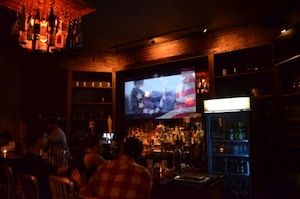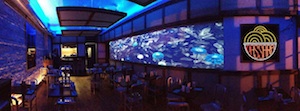A software industry vet by trade with a vision to combine technology and dining in a unique way, Ralph Jacobus epitomizes AV/IT convergence.
The installation at Dassara features a 21-by-4-foot edge-blended projection display using Mitsubishi short-throw projectors.
His concept was to integrate a simple to manage, cost efficient, and scalable solution to distribute compelling AV content and advanced lighting. The trick with restaurants is that the technology must complement the space without distracting patrons from the dining experience.
He set off for InfoComm 2011 with a mission to bring this concept to fruition.
Jacobus hatched the idea for Ramenwerk with a close friend that was in the process of developing a new ramen restaurant in Brooklyn. In March 2012, Jacobus quit his corporate consulting job to devote his full attention to creating this distinctive, tech-infused dining experience for the Brooklyn ramen house, Dassara. His ultimate vision was to create an easily scalable design to deploy in hundreds of other restaurants. He partnered with video industry veteran Ed Lewis as technical director, who has 20-plus years experience directing and programming advanced video walls and control systems.
The resulting installation at Dassara features a 21-by-4-foot edge-blended projection display, automated LED lighting, sound system, and 80-inch Sharp flat-panel TV with a mirror overlay.

Astera RGB LEDs illuminate a sake bottle chandelier in the bar area, opposite the 80-inch Sharp flat-panel with mirror overlay.
The star of the install is undoubtedly the projection display. Jacobus was told repeatedly that he needed high-end, 5,000-lumen-plus projectors that would cost him tens of thousands of dollars each. But Jacobus was determined to stay true to his concept of creating a solution capable of widespread implementation, so keeping costs down was a major element. “I’m not going to show Star Wars. I’m going to show art,” he mused, to justify his intended video requirements, so as not to distract from the food.
After testing several brands of projectors, Mitsubishi’s ultra short throw solutions, clocking in at 2,800 lumens, were the only ones that could deliver the image quality on his budget. He chose to mount three of them in burlap ceiling clouds paired with Dataton’s Watchout software and control from Medialon.
Known more for theatrical and museum control applications, Medialon appealed to Jacobus because it is PC-based, unlike other proprietary control systems on the market. Hailing from the software world, Jacobus insisted on using an open architecture based system.
The display rotates an array of varied artwork Jacobus curated himself, from Japanese pop art to urban folk panoramas. Dassara also uses the displays to show major sporting events.

Ralph Jacobus, Ramenwerk
The front-projector setup allows patrons to sit right up against the display wall without inadvertently becoming part of the display.
The LED lights are programmed to mimic the colors in the artwork, creating the effect of the artwork reflecting up the wall.
The audio system was an important consideration because Jacobus wanted to ensure Dassara guests could easily have conversation above the usual restaurant din and music. He selected a QSC mixed mono system for balanced distribution, with QSC’s CX108V amp. Jacobus quickly learned that creating a decent acoustical environment, often non-existent or an afterthought in restaurant design, doesn’t have to be difficult. “It just takes a little pre planning. It’s easy,” he said.
Other components include an Extron switcher and DSP mixer (DXP series switch), Philips Color Kinetics RGB LEDs, and Astera RGB LEDs in a sake bottle chandelier in the bar area.
Dassara co-owner Justin DeSpirito has noticed customers drawn in from the street by the displays. Some diners have even been spotted rearranging their chairs to face the displays after eating.
Jacobus’ divergent approach to AV recognized that in today’s installs, where every device could conceivably have its own IP address, the solution inevitably becomes an IT problem. He also recognized that integrators are increasingly selling to CIOs with a different set of values. He has developed a strategy to work directly with designers and architects early on to sell his concept.
Since launching Ramenwerk with the Dassara install, Jacobus has broadened the scope of potential applications beyond restaurants. Retail whitespace is one area of focus for Ramenwerk, a great option for retail pop-up space. Ramenwerk is also working on a project techorating a Hamptons villa, where Jacobus is working with a landscape designer to transform the outdoor space into a projected art display.
Now, he said, “I see projectors and screens everywhere.”














